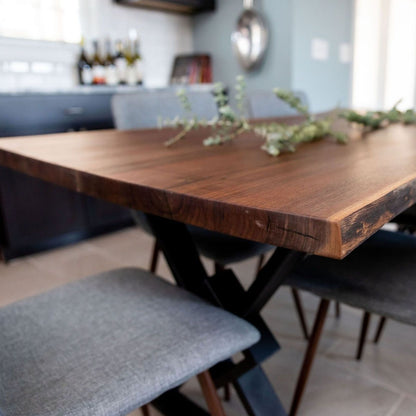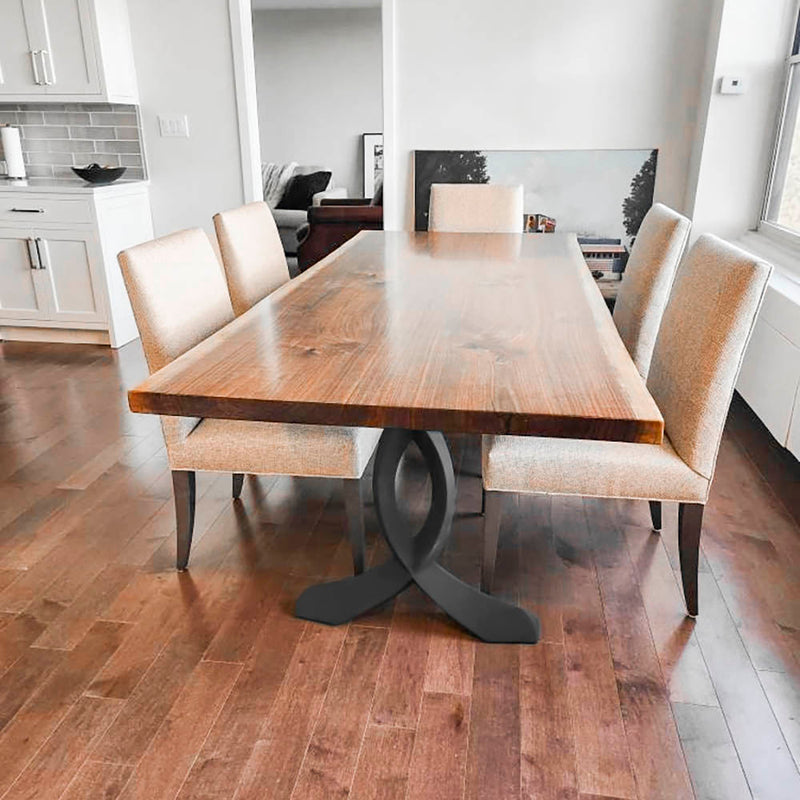The Impact of Dining Room Table Legs on Your Table's Overall Design
The Impact of Dining Room Table Legs on Your Table's Overall Design
Blog Article
From Conventional to Modern: Locate the Suitable Dining-room Table Legs for Your Style
While timeless styles such as cabriole and turned legs stimulate a sense of classic elegance, modern designs like hairpin and geometric alternatives offer a chance for striking aesthetic interest. As you take into consideration these components, the concern continues to be: just how can you perfectly integrate these varied leg styles to create a harmonious dining experience?
Understanding Table Leg Styles
The range of eating area table leg styles can significantly affect both the aesthetics and performance of the space. Each leg design contributes distinct useful functions and visual components, satisfying varied style preferences and use requirements. Comprehending these styles is critical for choosing the appropriate eating table that straightens with your total indoor design vision.
For example, conical legs supply a tidy, timeless look that can improve an area's elegance, while pedestal bases provide security and take full advantage of legroom, making them optimal for smaller areas. Hairpin legs, a trademark of mid-century modern-day design, present a commercial panache, permitting a ventilated, open feeling. Likewise, trestle legs evoke rustic charm, giving robust assistance and a sense of eternity.
In addition, the choice of materials plays a substantial duty. Wooden legs can bring warmth and structure, whereas steel options frequently share a sleek, modern ambiance. Ultimately, comprehending table leg designs is essential for creating a cohesive eating location that reflects personal style while ensuring functionality and convenience. By thoughtfully thinking about these components, you can boost both the useful and aesthetic appeal of your dining area.
Standard Table Leg Options
When picking eating space table legs, standard options commonly personify ageless sophistication and workmanship. These layouts reflect an abundant heritage and a commitment to top quality, making them perfect for those who value timeless aesthetic appeals.
Among the most iconic traditional leg styles is the cabriole leg, identified by its graceful rounded form. This design frequently features attractive carvings and is most typically located in Queen Anne and Chippendale furnishings. An additional popular choice is the transformed leg, which flaunts a collection of smooth, rounded forms that offer a classic look while keeping stability.
Furthermore, the straight leg, while simple, offers a unadorned and sturdy framework that can mix seamlessly with a range of tabletop designs. For those attracted to ornate outlining, claw-and-ball feet legs stimulate a sense of magnificence and can offer as a sensational centerpiece in any eating area.
Lastly, stand bases, although not strictly legs, give an alternate typical alternative that permits for ample legroom and can be beautifully sculpted. Each of these traditional leg styles adds to the general ambiance of a dining-room, marrying function with visual allure.

Modern Table Leg Styles
Modern table leg designs provide a Learn More diverse variety of designs that stress cutting-edge products and tidy lines. These styles frequently focus on functionality while functioning as striking centerpieces within a dining space. Minimal looks prevail, with legs crafted from materials such as steel, glass, and engineered wood, which contribute to a contemporary and airy feeling.
One popular style is the hairpin leg, defined by its slim, tapered structure look what i found that offers security without frustrating the tabletop (dining room table legs). This design is commonly discovered in mid-century contemporary furnishings and can easily match various table forms. Another pattern is the usage of geometric shapes, where legs may take on angular or unbalanced forms, including aesthetic rate of interest and a touch of artistry

Blending Designs for Special Areas
Usually, house owners look for to develop special dining areas that reflect their personal design by mixing different style elements. This approach permits for the unification of varied aesthetics, resulting in a harmonious yet distinct setting. For example, matching a rustic wooden table with streamlined, modern-day metal legs can produce an appealing contrast that elevates the area's general appeal.
In addition, incorporating vintage table legs with contemporary tabletops can evoke a sense of background while preserving a modern-day perceptiveness. Such mixes not only showcase private preference yet additionally encourage creativity, enabling home owners to curate a room that feels both best site individual and inviting.
Color plays a vital role in this blending process; choosing table legs that enhance or contrast with the existing color pattern can improve aesthetic interest. Whitewashed legs can soften the boldness of a dark table surface area, developing a balanced aesthetic.
Tips for Selecting the Right Legs
Picking the right table legs is necessary for achieving both performance and visual appeal in your eating room. Begin by thinking about the total design of your room. Standard setups gain from legs that feature complex makings or turned styles, while modern areas may call for sleek, minimalist styles.
Following, examine the height and stability of the legs. dining room table legs. Common eating tables range between 28 to 30 inches in height, so guarantee the legs complement this dimension for comfort. Furthermore, robust products, such as wood or steel, can improve stability and longevity
Assess the leg form also-- alternatives consist of directly, tapered, or pedestal layouts. Straight legs provide a traditional appearance, while tapered legs can include a touch of elegance. Pedestal bases offer enough legroom and are suitable for smaller areas.
Verdict
In recap, choosing the suitable eating room table legs requires cautious consideration of both traditional and modern designs. Standard alternatives such as cabriole and transformed legs supply ageless beauty, while modern styles like barrette and geometric forms offer a modern touch. By integrating leg design, elevation, and material with the total decoration, a cohesive and welcoming ambience can be accomplished. Ultimately, the selected table legs should reflect the preferred visual, enhancing the dining experience within the area.
The selection of dining space table leg styles can significantly affect both the appearances and capability of the space. Ultimately, recognizing table leg styles is essential for developing a cohesive dining area that mirrors personal design while guaranteeing functionality and comfort.One of the most famous standard leg styles is the cabriole leg, identified by its stylish bent form. Straight legs use a traditional appearance, while conical legs can add a touch of style.In recap, selecting the ideal eating area table legs calls for mindful consideration of both standard and contemporary styles.
Report this page